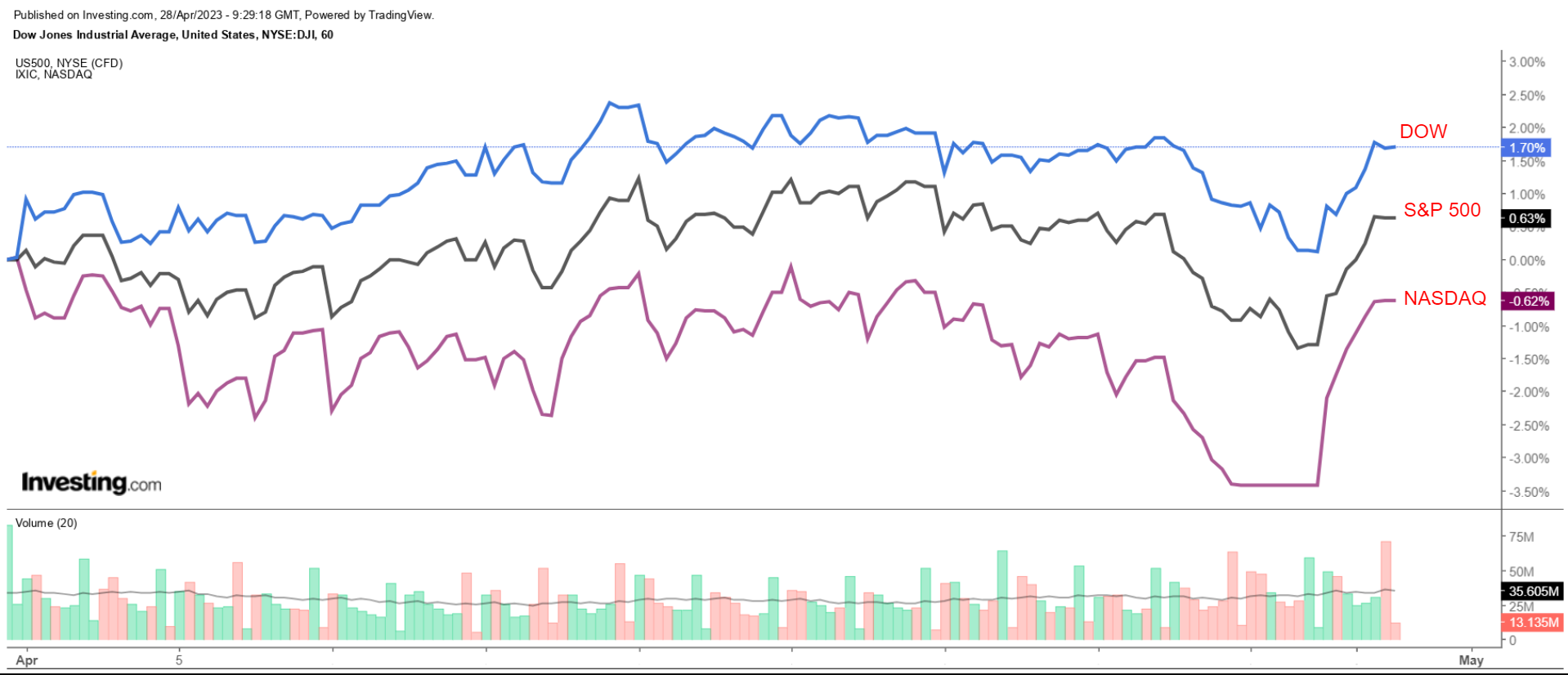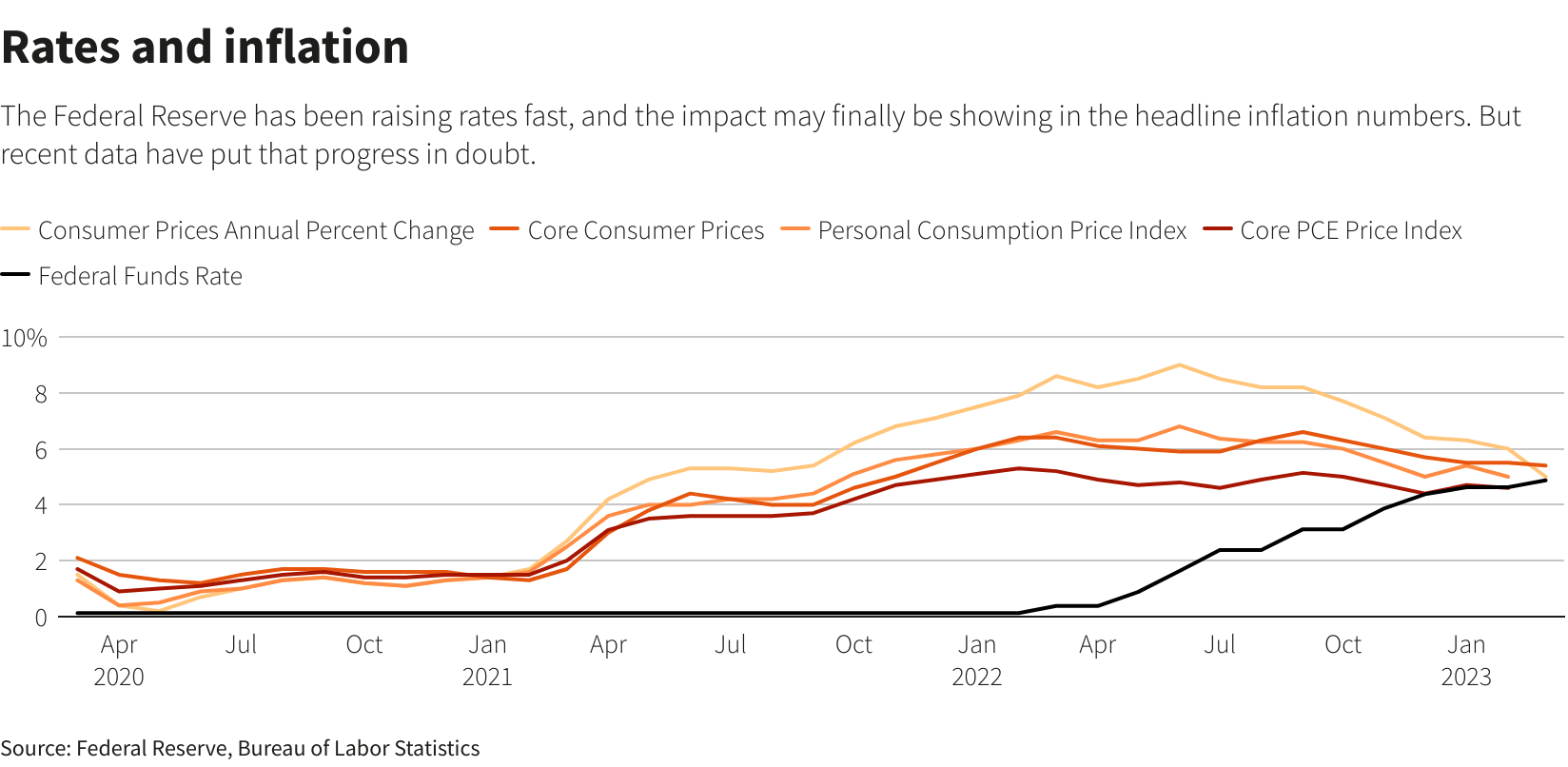Bitcoin set for a rebound that could stretch toward $100000, BTIG says
- May is expected to be another volatile month on Wall Street.
- Investor focus will be on the Federal Reserve’s policy meeting, the monthly jobs report, inflation data, more earnings, and the U.S. debt ceiling.
- Investors should brace for more violent swings and sharp moves in the month ahead.
Stocks on Wall Street are on pace to end April on a decidedly volatile note as investors grow increasingly worried over the impact of high interest rates, inflation, and a potential U.S. recession.

The blue-chip Dow Jones Industrials Average is on track to come out on top in April, with a roughly 1.7% gain heading into the final trading session of the month. The benchmark S&P 500 index is about 0.6% higher this month.
Meanwhile, the tech-heavy Nasdaq Composite is set to be the biggest laggard in April, down 0.65% as of Thursday’s close.
As a wobbly April comes to an end, investors should prepare themselves for fresh turmoil in May. This month kicks off a historically weak period in which the stock market tends to underperform in the six months from May to October.

Since 1990, the S&P 500 has gained an average of about 2% from May through October. That compares with a roughly 7% average gain from November through April.
Some have dubbed this seasonal divergence “Sell in May and Go Away."
With investors continuing to gauge the outlook for interest rates, inflation, and the economy, a lot will be on the line in the month ahead.
1. Wednesday, May 3: Fed Rate Hike, Powell Speech
The Federal Reserve is almost certain to follow through with its tenth consecutive rate hike at the conclusion of its two-day policy meeting on Wednesday, May 3.
As of Friday morning, financial markets are pricing in an 89.5% chance of a 25-basis point rate increase and a 10.5% chance of no action, according to Investing.com’s Fed Rate Monitor Tool.

If the Fed does, in fact, deliver a quarter-percentage-point rate hike next week, it will put the benchmark Fed funds target range in a range between 5.00% and 5.25% that policymakers previously projected would likely be the peak for the current round of policy tightening.
Beyond the expected rate move, Fed Chair Jerome Powell will hold what will be a closely watched press conference shortly after the release of the Fed's statement.
Powell will have to send some signal about what happens next - whether to keep the language from the March policy statement that "some additional policy firming may be appropriate" or point to a pause.
Investors are currently betting that next week’s rate hike will be the last one in the Fed’s current tightening cycle. Traders have also priced in at least one 25bps rate cut by the end of 2023 amid mounting fears over a looming economic downturn.
Prediction:
- It is my belief that the Fed will continue to raise interest rates in response to recent data showing inflation remains persistent. At the same time, the broader economy seems poised to continue growing, even if slowly.
- While I agree that the current tightening cycle may be close to the finish line, I reckon the policy rate will need to rise another half of a percentage point to between 5.50% and 5.75% before the Fed entertains any idea of a pause or pivot in its battle to restore price stability.
- The U.S. central bank is at risk of committing a major policy error if it starts to ease policy too soon, which could see inflationary pressures begin to reaccelerate.
- I expect Powell will reiterate his determination to bring down sticky inflation while stressing the point that the Fed will be responsive to incoming data through the summer and into the fall as it considers the direction of its next policy decision.
- One thing is for certain: given how inflation and the economy are behaving, the fewer promises Powell and the Fed make, the better.
2. Friday, May 5: U.S. Jobs Report
The first big piece of data to come out after the Fed’s policy meeting will be the U.S. jobs report, and it will likely be key in determining the U.S. central bank’s next move.
The Labor Department will release the highly anticipated April nonfarm payrolls report on Friday, May 5, at 8:30 AM ET. Forecasts center around a continued solid pace of hiring, even if the increase is smaller than in previous months.

The consensus estimate is that the data will show the U.S. economy added 181,000 positions, according to Investing.com, slowing from jobs growth of 236,000 in March.
The unemployment rate is seen edging up by one tick to 3.6%, staying close to a recent 53-year low of 3.4%.
Officials have signaled that the unemployment rate needs to be at least 4.0% to slow inflation, while some economists say the jobless rate would need to be even higher.
Either way, low unemployment - combined with healthy job gains - points to more rate hikes to come in the months ahead.
Prediction:
- I believe the April jobs report will underscore the remarkable resilience of the labor market and support the view that more rate hikes will be needed to cool the economy.
3. Wednesday, May 10: U.S. CPI Data
The April CPI inflation report looms large on Wednesday, May 10, and analysts expect it could be hotter than March’s 5.0% year-over-year pace, suggesting that the Fed will maintain its fight against inflation.

As per Investing.com, the consumer price index is forecast to rise 0.2% on the month after edging up 0.1% in March. The headline annual inflation rate is seen rising 5.2%, compared to a 5.0% annual pace in the previous month.
U.S. CPI peaked at 9.1% in July and has been on a steady downtrend since, however, inflation is still well above what the Fed would consider consistent with its 2% target range.
Meanwhile, the core CPI index is expected to rise 0.4% on the month and 5.6% from a year ago. The core figure is closely watched by Fed officials who believe that it provides a more accurate assessment of the future direction of inflation.
Prediction:
- Overall, while the trend is lower, the data will likely reveal that neither CPI nor core CPI is falling fast enough for the Fed to slow its inflation-fighting efforts this year.

Taking that into account, I believe the Fed is likely to hike rates again in June and July as long as inflation remains at elevated levels and the labor market stays resilient.
4. Earnings Season Continues
Investors await a flood of earnings in May as Wall Street’s first quarter reporting season continues.
Apple (NASDAQ:AAPL) will be the last ‘FAAMG’ stock to report quarterly results when it releases fiscal second-quarter earnings after the market closes on Thursday, May 4.
Other notable companies joining AAPL in reporting earnings next week include Advanced Micro Devices (NASDAQ:AMD), Qualcomm (NASDAQ:QCOM), Coinbase (NASDAQ:COIN), Block (NYSE:SQ), Shopify (NYSE:SHOP), Uber (NYSE:UBER), Ford Motor Company (NYSE:F), Starbucks (NASDAQ:SBUX), Pfizer (NYSE:PFE), Moderna (NASDAQ:MRNA), and DraftKings (NASDAQ:DKNG).
The following week sees high-profile names like Walt Disney (NYSE:DIS), PayPal (NASDAQ:PYPL), Robinhood (NASDAQ:HOOD), Airbnb (NASDAQ:ABNB), Palantir Technologies (NYSE:PLTR), Roblox (NYSE:RBLX), Lucid Group (NASDAQ:LCID), Rivian Automotive (NASDAQ:RIVN), Occidental Petroleum (NYSE:OXY), and Beyond Meat (NASDAQ:BYND), report earnings.
Retailers then take center stage in the last full trading week of the month when heavyweights Walmart (NYSE:WMT), Target (NYSE:TGT), Home Depot (NYSE:HD), Lowe’s, TJX Companies (NYSE:TJX), and Costco (NASDAQ:COST) deliver their latest financial results.
Another key name to watch will be Nvidia (NASDAQ:NVDA), whose Q1 results are scheduled to come out after the closing bell on Wednesday, May 24.
Expectations for Q1 earnings have drastically improved, with analysts now projecting a 2.4% year-over-year drop for profits at S&P 500 companies compared to a 5.1% decline forecast at the start of the earnings season, according to FactSet.
Of the 235 S&P 500 companies that have reported earnings through Thursday, about 79% have reported positive surprises, according to FactSet data. In a typical quarter, 66% of S&P 500 companies beat estimates.
5. Debt Ceiling Drama
Fresh uncertainty on the political front may also shape how Fed officials weigh the risks facing the U.S. economy and whether they decide to pause further rate increases.
The U.S. Treasury Department could run out of ways to pay its bills in a matter of weeks if Congress fails to pass a bill to raise the government's $31.4 trillion debt ceiling, raising the risk of a historic U.S. debt default.
Lawmakers do not know precisely how much time they have left to act, but the "x-date" could come as early as the first week of June.
Republican House Speaker Kevin McCarthy has called on President Joe Biden to begin negotiations on raising the debt ceiling and spending-cut bill, even as the White House and congressional Democrats insist on a debt limit increase with no strings attached.
For Fed officials, the political standoff could influence their view of whether the economy and inflation are likely to slow more - perhaps much more - quickly than anticipated.
If that were the case, then the market would be forced to reprice rate expectations to reflect additional easing by the end of the year.
Disclosure: At the time of writing, I am long on the S&P 500, and the Nasdaq 100 via the SPDR S&P 500 ETF (SPY), and the Invesco QQQ Trust ETF (QQQ). I am also long on the Technology Select Sector SPDR ETF (NYSE:XLK). I regularly rebalance my portfolio of individual stocks and ETFs based on ongoing risk assessment of both the macroeconomic environment and companies' financials. The views discussed in this article are solely the opinion of the author and should not be taken as investment advice.

